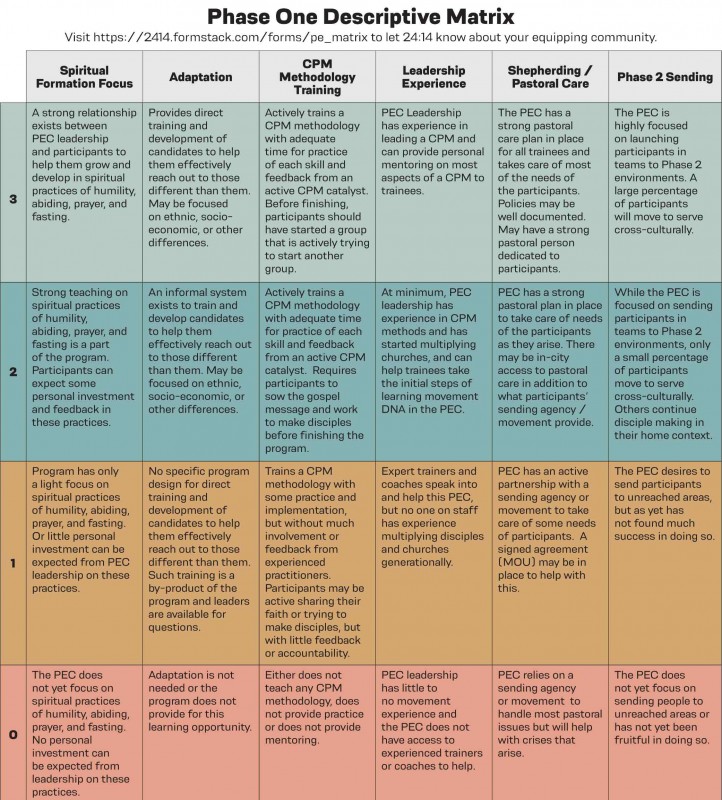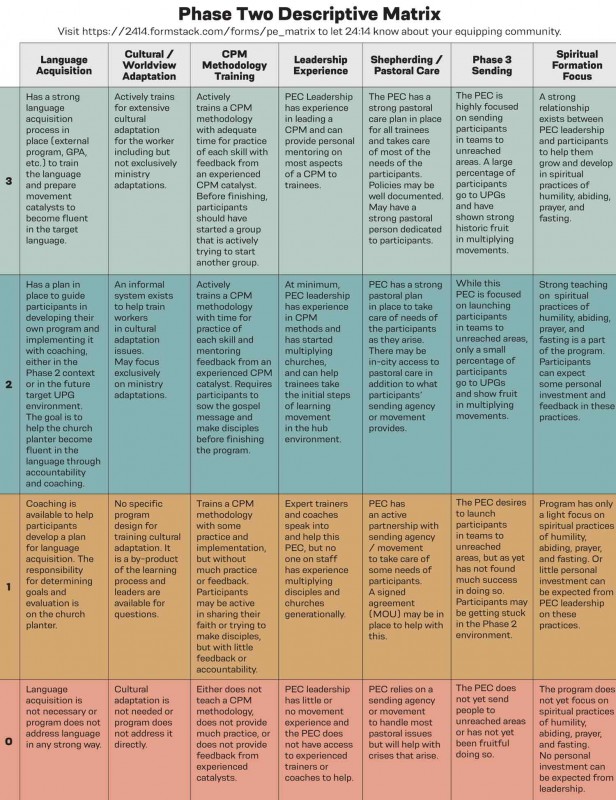The Next Evolution Of Movement - Catalyst Phased Equipping
24:14 Goal Movement engagements in every unreached people and place by 2025 (58 months)

Raising Up New Movement Catalysts for the Harvest
Kingdom Movement models have turned the world of missions among the unreached upside down. Segment by segment, people by people, place by place, movement engagement is realigning expectations back to book-of- Acts proportions. New missionary candidates now wrestle with higher longings for fruitfulness. They are looking for those who can train and mentor them into living out those expectations. The catalyst’s profile is no longer Western, seminary trained and laboring with low expectations. With over 1,300 global book-of-Acts movements starting over the past 25 years and adding nearly 70 million people to God’s family globally, grand expectations for the future don’t seem so far-fetched.
The Concept
Two articles defined a conversation around missionary training: “Training Movement Catalysts,” by Stan Parks (Mission Frontiers, March-April 2016) and “Four Stages to No Place Left In Our Generation,” by Steve Smith (Mission Frontiers, Sept-Oct 2016). Steve and Stan awakened us to a training model based on mentoring rather than classroom training. This phased training approach envisioned a mobilized army of catalyst candidates, readying themselves for the harvest field by training under experienced movement catalysts. Those experienced catalysts would model the methods, assist in practice, watch and give feedback and launch candidates to the next frontier of lostness.
For the past two years, members of the 24:14 community have been tracking with those who have been experimenting with these models. We initially entitled the concept “CPM Training Hubs.” While the concept of phased learning has been gaining momentum, many in our community have eschewed the word “hub” because of its overuse, emphasis on location rather than process and confusion with operational endeavors.
As we started examining God’s work globally, we recognized that His work could be better captured in principle than in structure. As a result, we have starting describing this process as “phased equipping” for CPM catalysts. We refer to the training environments using these principles as Phased Equipping Communities (PEC). This name seems best to use going forward.
We summarize the essential principles as follows.
New movement catalysts need preparation to go to the gaps in unreached peoples and places.
Catalysts are best prepared by a process of training, modeling, personal experience, and coaching with CPM tools rather than simple training in classroom settings with little practice. Practical experience with input and feedback from a coach offers the fastest way to reach effectiveness.
Learning CPM in one’s home environment before moving cross-culturally greatly speeds learning and prepares candidates for greater effectiveness. The most effective catalysts have already served as leaders in a mature movement.
A Vision for PEC Training
Step 1—Promote phased learning regionally in partnership with existing movements, churches and organizations.
Step 2—Describe and document existing phased learning environments to form a network.
Step 3—Resource materials and coaching for those wanting to start phased learning environments.
We see a number of different structures emerge that are true to these principles. They usually follow the phases we have described previously and expand on here:
Phase 1—New movement catalysts are trained in multiplicative movement approaches in their home cultural context. This disciple-making training enables the catalyst to learn evangelism, discipleship, church formation and multiplication through hands-on experience.
Phase 2—In this second phase of training, movement catalysts relocate to a field location in which they adapt to a cross cultural environment and contextualize use of CPM tools in an unreached area. These Phase 2 assignments can take place in a variety of contexts—from catalysts laboring to start a movement to mature movement environments. In any case, the Phase 2 experience is facilitated by leaders with real movement experience.
Successful Phase 2 environments both help candidates discern gifting and fit, and help them catch a vision for unreached peoples and place gaps. The unwavering goal is engaging the remaining unreached peoples and places with a movement effort. At the same time, this Phase 2 process also helps each participant find his or her best place of effectiveness toward that goal.
Catalysts have different training needs, depending on where they originate and where they plan to serve. The needs may include support raising, pastoral care, resiliency, language and culture training, and other topics. Those sponsoring Phased Equipping Communities set up programs to meet these training needs and include these modules in either Phase 1 or Phase 2 learning environments, depending on the organization and the needs of the candidates.
Phase 3—Phase 3 involves new catalysts engaging a new UPG environment. Moving from a Phase 2 environment to a new UPG is often challenging because of the comfort, support, training and development the Phase 2 offers. The emphasis in Phase 3 moves from the community based learning environment of Phase 2 to a remote coaching environment.
Phase 4—This phase involves a maturing movement raising up and sending their own catalytic workers to other UPGs. We see the importance of this phase in the fact that around 80% of global movements are being started by existing movements. Thus assisting these movements in new worker catalyzation is incredibly strategic in reaching the remaining unreached peoples and places.
A Descriptive Matrix
Because of the diversity of these Phased Equipping Communities, describing them generically can be a challenge. The focus of the training process differs with different environmental factors and factors unique to various candidates’ needs for culture and language training. Some communities combine multiple sending organizations and their care networks, while others only work within one organizational context.
Given the number of models being used and the varying situations, how can we describe and evaluate these Phased Equipping Communities? The 24:14 Coalition currently uses a matrix (see below) for leaders to self- describe their Phased Equipping Communities. Others in mobilization networks can then use the matrix score to help identify good places for their candidates to receive training.
The matrix variables include language acquisition, cultural adaptation, CPM methodology training, shepherding (pastoral care), spiritual formation, and next phase transition. We have designed the matrix to give an overall picture of a location’s focal points, irrespective of the community’s environmental requirements.
Leaders of Phased Equipping Communities can also use the matrix to self-evaluate their programs and seek to improve thei process. As we have brought together PEC facilitators, we have often noted “best practices” emerging and leaders learning from one another. At the same time, we found that the principles were not always universally applicable because of the situation in different environments.
Phased Equipping Communities: What We Hope to See
A variety of different models embody these training principles; we plan to examine these in another article. This article mainly aims to explore what training movement catalysts can and should do to promote a phased equipping approach. We offer an invitation to look not at “what we can do,” but “what needs to be done” to finish the 24:14 vision of reaching every unreached people and every global place. We see three steps needed: a way to promote
the growth of phased equipping, a mobilization network, and equipping for those who want to launch these learning environments.
A strategy for equipping and sending new laborers region by region could use a variety of phased equipping models. It could help mobilization networks equip and prepare outsiders to be effective. It could also work with existing churches and networks to train them in movement methods to engage new areas. And it could assist existing movements in sending their catalysts cross culturally.
We want to promote a variety of phased equipping models championed by our community through global meetings, our website, training materials, blog posts and podcasts.
A second goal is to catalog the existence of Phased Equipping Communities globally and provide a way to describe and evaluate them through the matrix. Mobilizers could connect with the 24:14 Coalition to see where PECs exist. They could use general information about the various PEC locations to develop relationships with existing communities that could aid in training their catalysts. Movement leaders can connect with PECs to help them train and launch their own movement catalysts to cross-cultural fields. We anticipate this will assist new movement catalysts in engaging new harvest fields.
24:14 has gathered a number of resources for use by teams and churches who want to start a PEC. With simple curricula using different methodologies, these resources offer multiple options for use in different environments. Teams and churches wanting to use these resources can ask to be connected with another PEC farther along in their journey, creating a web of assistance for those wanting to learn from others.
Final Thoughts
We don’t aim to promote a single model of CPM equipping. Rather promotion of the principles could allow for many effective movement catalysts to go to unreached peoples and places globally. With the 24:14 vision calling for saturation of global districts and UPGs with movement engagements, we need many new laborers for the harvest in the years ahead. Only God can start movements, yet our role includes helping catalysts find ways to quickly become effective practitioners. Phased Equipping Communities offer a pathway to this learning and an important role in the Body of Christ’s completion of the Great Commission.










comments